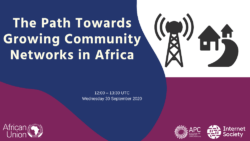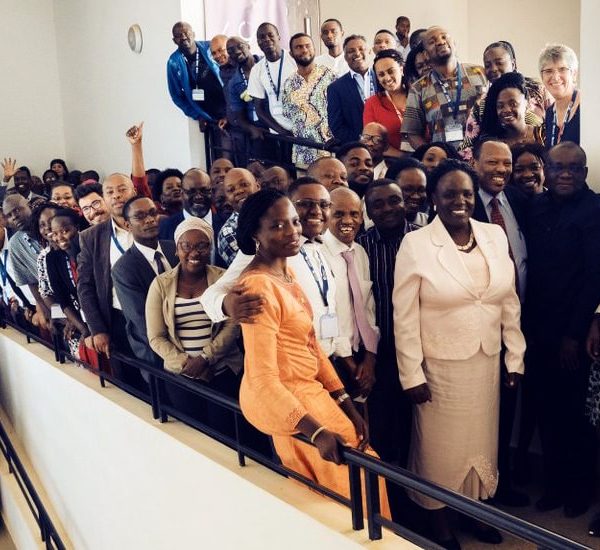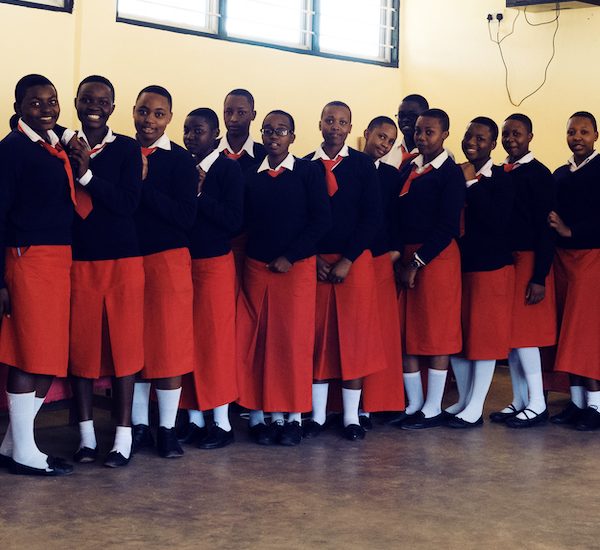Webinar Summary Report
Unlike past events, the 5th Summit on Community Networks in Africa took place online. The event consisted of 5 sessions organized by the Internet Society (ISOC) in partnership with the Association for Progressive Communications (APC) under the patronage of the African Union Commission (AUC) between September 2020 and February 2021.
Overview of discussions
The first webinar in the series, aimed at providing clear guidelines on how to build a Community Network (CN) in Africa. It attracted over 90 participants. Josephine Miliza, Network Engineer and Africa Regional Coordinator, APC-LOCNET Project opened the session by welcoming participants and providing an overview of the previous summit in Dodoma. Finally, she introduced the new Program Committee (PC) 2020 and welcomed representatives from the African Union Commission (AUC), the Association for Progressive Communications (APC), and the Internet Society (ISOC), who gave remarks.
Mr. Moses Bayingana, Senior Policy Officer for ICT, AUC, shared the AU’s digital transformation strategy for 2020-2030. He highlighted that digital infrastructure is a foundation pillar of the strategy and that to reap the benefits of digital transformation, abundant low-cost connectivity is essential as it drives productivity, innovation, and growth.
Jane Coffin, Senior Vice President, Internet Growth, Internet Society, made the case for more connectivity in rural communities. She said the COVID-19 pandemic has highlighted the critical importance of the Internet and called for better collaboration between governments and other stakeholders. She urged authorities and development partners to see community networks as a compliment to connecting the unconnected. Finally, she called for communities to work together with the Internet Society on local strategies and approaches that can help to scale and increase the growth of community networks in Africa.
Dr. Carlos Rey-Moreno, Project Coordinator, APC, reflected on the growth of community networks across the continent thus far. He recognized contributions from different institutions, including the AUC and the Uganda Communications Commission in fostering the growth of community networks in the continent.
Panel discussions:
Panelists included:
- Chako Armant – Project Manager, La-difference (PamojaNet Community Network), the Democratic Republic of Congo (DRC);
- John Dada – Board chairman, Fantsuam Foundation, Nigeria; and
- Kgopotso Ditshego Magoro, Mamaila Community Network, South Africa.
Barrack Otieno, Director of AHERI Community Networks and trustee of the Kenya ICT Action Network, moderated the session.
It started with a trailer video that reflected previous summits, followed by questions directed to panelists by the moderator.
How to establish a community network
The panel discussion focused on the path to starting and operating community networks. The sharing revealed insights on motivation, approaches, services, challenges and opportunities, and funding.
Motivation
On motivation, panelists stated that needs drove the establishment of community networks. Fueled by factors such as lack of access to information, high costs of Internet data, insufficient computers and libraries for learners and general lack of Internet connectivity, communities worked to establish their own Internet networks. For instance, Chako, Armant shared that PamojaNet was started following the request of communities in the IDJWI Island in DRC to have access to information. With no connectivity On the Island, people could not seek, receive, and impart information effectively. Today, PamojaNet is the gateway to information for the population.
Another strong motivating factor is peer pressure and learning. People with great digital capabilities and aspirations within communities influence their views on community networks. Similarly, existing strong community networks around communities provide an opportunity for peer learning.
Approach and governance
Community networks are established as an approach to respond to local access priorities and challenges. Experiences from the panelists showed that establishing a relationship and collaborating with the local government and cultural authorities from the onset are recommended as entry points for the community to buy into the concept. Panelists also shared that community networks thrive at the cross-section of broader community development paradigms like microfinance and local businesses.
Also, community engagement is critical for the establishment and governance of a community network. Awareness creation and the involvement of the community in the complete process of the establishment of a community network is key to its success. Communities need to conduct a needs assessment, identify volunteers, and work to ensure proper installation of the network infrastructure. The community engagement approach is central to establishing a sustainable community network in any community. John Dada, for instance, indicated that Fantsuam was started in a single room, as a small Community Learning Center (CLC) project in 1997 for students from the area to have access to the Internet. Today, with the help of the community, it built its facilities at a centralized location and serves over 200 students and community members. To date, Fantsuam has supported over 500 small road-side businesses to register online and access government support.
Challenges and opportunities
Community networks cut costs of telecommunications, retain communications expenditure within communities as a form of social entrepreneurship, and support the development of the community as it provides connectivity to people. However, as panelists noted, community networks do not go without challenges. They face a number of challenges that must be carefully handled. One big concern mentioned includes digital illiteracy among community members. Some communities lack the adequate technical capacity to independently operate and maintain their community network. For the community network to be reliable and utilized, panelists advised that the community requires continuous training on ICTs.
Besides skills, expensive and unreliable broadband affect the day-to-day online activities of communities. Other challenges include unreliable power supply, poor road networks, theft, and destruction of the infrastructure.
Despite the challenges, community networks have built resilience over the years that enable them to keep thriving. Investing in solar power backups, centralizing community network facilities, and seeking external support are some techniques communities have used to address some of the challenges. With community networks, you learn to adjust to your local reality as you keep learning to innovate.
Other questions:
During the question and answer session, participants asked over 20 questions. While the panel responded directly to some questions during this session, others were discussed via the WhatsApp group set up for community networks in Africa. Here is a highlight from the session.
- Dealing with power cuts: Community networks often face power cuts. To deal with power blackouts, panelists advise operators to practice energy mix; using the grid when they can and find solar backups. Though solar can be costly, it has a long-term reward. Solar power can enable stable energy production and are cleaner than diesel generators, which uses petrol to power up.
- Applying for a license: Panelists responded to the question of licensing for community networks. In some countries across Africa, community networks need to register and be granted licenses to operate. Panelists advise that once applying for a license, community network operators should have a good motivation as to why they require a license. The purpose could be, for instance, to connect the communities to bridge the digital divide.
- Centralize or decentralize a community network? On this question, panelists said it depends on the local context. The Fantsuam Community Network had, for example, decentralized to 4 locations but 3 became impossible to sustain due to community violence and lack of access to broadband. It needed to centralize to a single location to ensure better protection and maintenance.
- Does guaranteeing free access to Internet mean access to information? The panel answered the question of whether guaranteeing free access to Internet via community networks means automatic access to information. They revealed access to information cannot be completely guaranteed while providing free access to broadband, since public wifi can exist and sometimes you need to provide opportunities for the community to access information such as setting up a television network or an information center.
Interventions needed to advance community network development in Africa
The exchanges revealed clear interventions needed to strengthen the growth of the community network movement in Africa. They include:
- The AU can encourage the Nigerian Government regulators to recognize community networks to enable its growth;
- For inclusion, we must not leave out the disabled and old communities. Targeted interventions for such vulnerable communities are needed;
- Local Internet Society chapters from countries could link up with AU African Digital Initiatives to see how it can benefit the local communities they represent;
- There is a need for increased collaboration amongst existing community networks. They need to collaborate to support the establishment of new community networks in other unconnected communities; and
- Stakeholders should recognize and value the strengths and capabilities of local community people as opposed to imposing on them external solutions to their community challenges.
Key take-away
There is increased recognition of the role of community networks in helping Africa connect the unconnected. What is becoming clear is that when communities share local strategies and approaches it enables learning and collaboration. Thus, continuous learning on how to improve existing community networks and scale growth should be strongly encouraged.
Written by Lillian Achom, Co-founder, AccessPlus and PC co-chair, Summit on Community Networks in Africa


